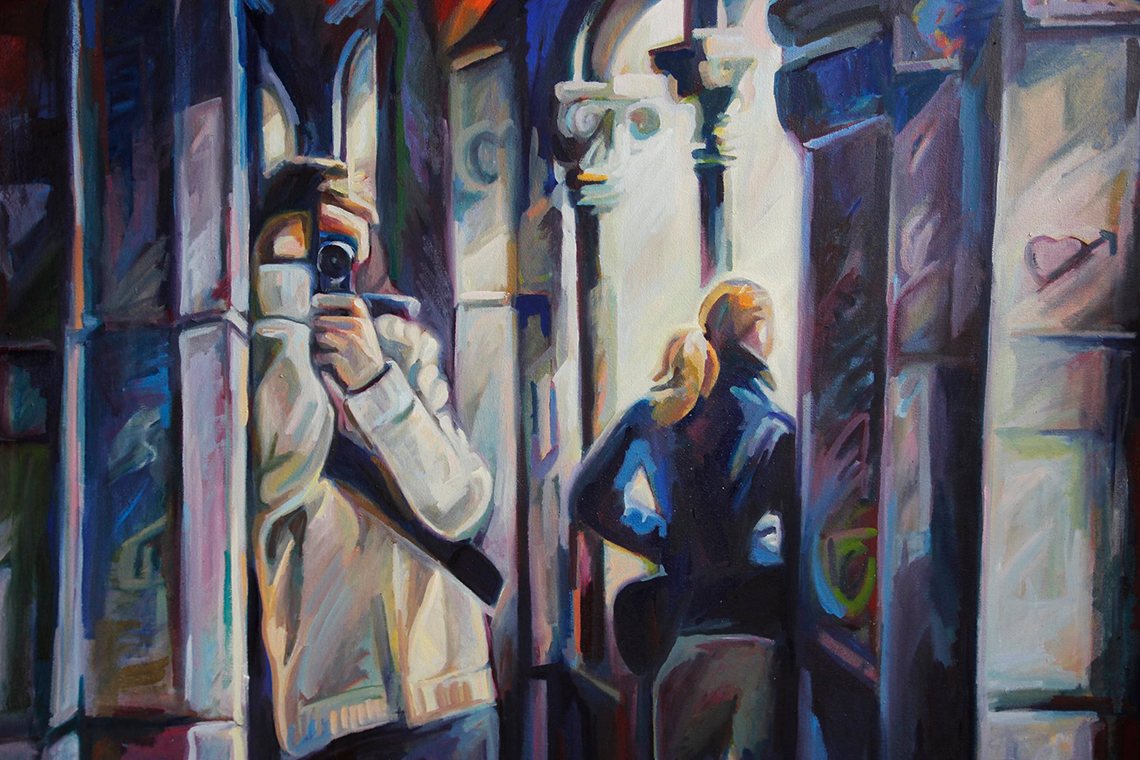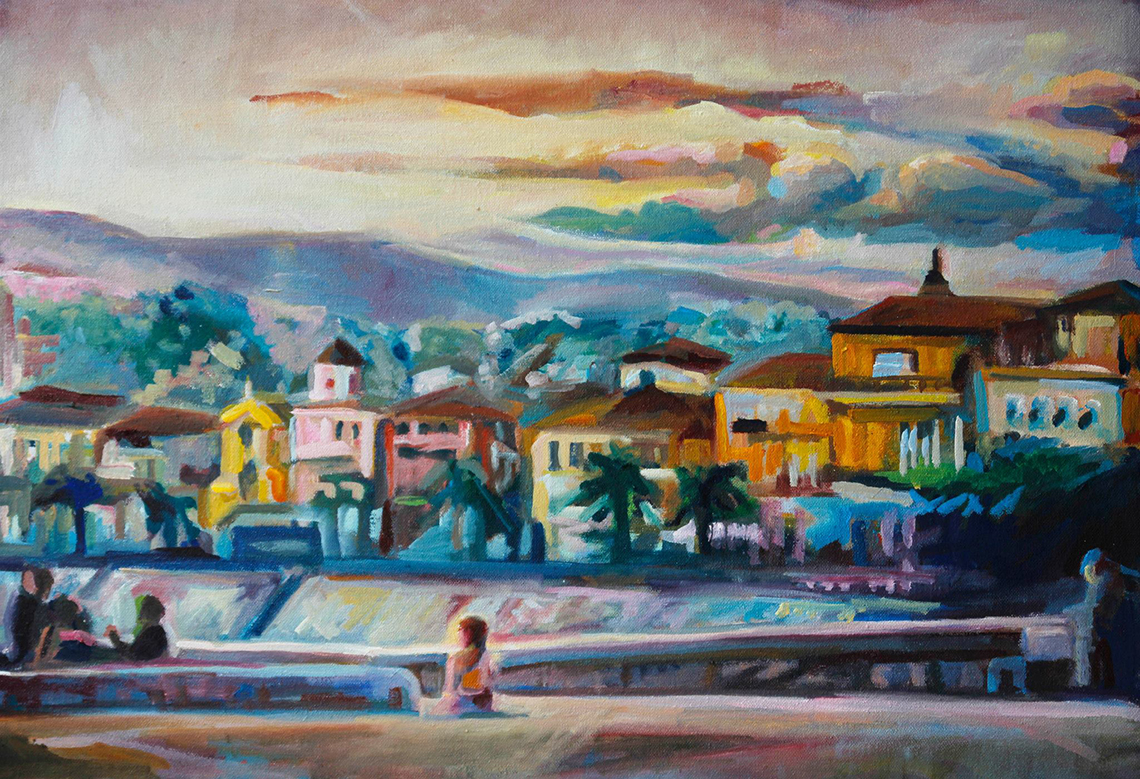It practically goes with out saying, but colors are one of the chief motivating elements for me in painting. I suspect that my romanticism with colors begins with color theory. I wish to discuss a few of own personal views on the subject, with just three beginning categories: Complimentary colors, Analogous colors, and Warm and Cool colors.
1. Complimentary colors:
 In my view complimentary colors are the first lesson to learn if you want to make your colors more bold and stand out more. Some art classes will teach monochromatic and analogous colors first, which does makes some sense. However, I feel like those first two are much more boring than compliments. One of my favorite art lessons back in early college was when I first painted yellow lemons with a purple background. It was simple, but just following that simple idea, took a mediocre painting and brought in an added “wow” element.
In my view complimentary colors are the first lesson to learn if you want to make your colors more bold and stand out more. Some art classes will teach monochromatic and analogous colors first, which does makes some sense. However, I feel like those first two are much more boring than compliments. One of my favorite art lessons back in early college was when I first painted yellow lemons with a purple background. It was simple, but just following that simple idea, took a mediocre painting and brought in an added “wow” element.
For those that don’t already know, complimentary colors are two colors at opposite ends of the color wheel. As the name suggests, when the two “opposite” colors are placed next to each other they “compliment” each other, make each other stand out more. Yes, purple and yellow are compliments, that’s why when you place bright yellow lemons against purple, the best of both colors are brought out “pop” that much more.
Complimentary pairs include: Purple & Yellow (think rich and elegant), Red & Green (think Christmas), and Blue & Orange (think athletic colors).
Sadly, when you actually mix compliments together, you get either black or mush (er, I mean “brown”). As a rule, you should never use true black in a painting (unless you have a very express purpose), so all my shadows and “blacks/darks” are actually a mix of compliments.
2. Analogous colors:
I used to think analogous colors were kinda boring (and still sorta do). However, they are just as important. Analagous colors are those next to each other on the color wheel. There are more combinations of pairings involved like: Green & Blue, Blue & Red, Red & Orange, Orange & Yellow, or Yellow & Green.
The best thing about analogous colors, is that they mix very well, and can create that exact tone, temperature, or shade/hue of color you want. If you have a green and want more coolness, add some blue (which of course is an ingredient in green: blue & yellow). If your red is too bold and you want to soften it a touch, without loosing the drama, add some orange or yellow (an ingredient in orange: yellow and red).
I kept mentioning “an ingredient in_” because in my view, that’s one of the most important lessons with analogous colors. If yellow is a main ingredient in orange, then wouldn’t orange and purple have some sort of distant complimentary relationship too? And if red and blue make purple, then wouldn’t red, blue, and purple be an analagous combination that would look great against yellow (like in Dancer) or orange?
In Dancer, I used that red and blue (and therefore purple) analogous pairing. And from there I used just a touch of yellow to create the complimentary lights that “pop”. Analogous colors, at least in my prejudiced mind, might not always be the most glamorous, but without their flowing and mixed pairings, there would be nothing to place those dramatic compliments against.
And yes, I have a particular fondness for yellow and purple compliments when I can get away with it.
3. Warm and Cool colors:
 One of the more psychological and intuitive (and therefore one of my favorite) aspects of color theory are “warm” and “cool” colors. When you think warm/hot, most would say “Red, orange, yellow” and cool would be “blue and purple” with green in between. Generally speaking, warms stand out more for “foreground” images, and cools are more for “background” elements. That’s the initial lesson, however, there’s so much more to it!
One of the more psychological and intuitive (and therefore one of my favorite) aspects of color theory are “warm” and “cool” colors. When you think warm/hot, most would say “Red, orange, yellow” and cool would be “blue and purple” with green in between. Generally speaking, warms stand out more for “foreground” images, and cools are more for “background” elements. That’s the initial lesson, however, there’s so much more to it!
Not all reds are truly “warm” and not all blues are actually “cool”. This is where it gets a bit hard to describe, but certain blues are a lot warmer than others. I personally consider cyan, or sky blue, to be a warmer blue than aquamarine blue. Maybe it’s because I see a “cool ocean” in aquamarine blue, or I see a “warm sunny sky” in cyan. Therefore, you never have to be stuck using just reds in front and blues in back. If you have a blue object in the foreground, you can either choose to use a warmer type of blue, or a cooler red (like a crimson) behind it. OR if you really want a challenge, use true cool colors for all your foreground elements and true warms for the background, and see what an unusual, dramatic vibrancy they create.
One of the first times I attempted using the unusual palette of cools in the front and warms in the back was in this pastel from Arezzo, Italy. It’s a pretty simple piece, just the trees, but this has since become one of my favorite color palettes, and I learned a lot from there.
Color Theory in Action:
In Are We Human, Skateboarder 1, I used an analogous combination of yellow and orange for the center and then deep blue to purple shadows along the edge. Blue is the compliment of orange and purple is the compliment of yellow, so I was really happy about how well it all coalesced.
At the same time, I generally aimed for an idea of a “warm” sunset, so even though I used both blues and oranges, the entire piece gives off a warm vibe, while still representing a hint of chillness that comes when the sun sets. The crimsons I used (mixed with some yellows to make some of the oranges) are cooler reds to reflect the diminishing sun.
 In Are We Dancers, I used similar colors, but to a different effect. I used more yellow and less orange, and more blue, less purple. Since my compliments weren’t as exact, my blue shadows and yellower highlights don’t contrast as much, but form a softer, more pleasant feel. I also used some green in the center top, which works well, as green is the center of the color-temperature spectrum.
In Are We Dancers, I used similar colors, but to a different effect. I used more yellow and less orange, and more blue, less purple. Since my compliments weren’t as exact, my blue shadows and yellower highlights don’t contrast as much, but form a softer, more pleasant feel. I also used some green in the center top, which works well, as green is the center of the color-temperature spectrum.
But I can’t hold back that much. With all the soft and colorful lighting, I then get to make the focus the guy’s bright red shirt which stands out and makes him the center. Since I held back and only used my warmest color in the center, I get to make the statement that this guy, who I equate to a “dancer” (hence the title of the piece) is important. I don’t have to explain why or say it in words- I get to just let the colors say it for me.
Color theory is a language art uses to make its statements without words.
All the bests,
Kate
For more information regarding warm and cool, analogous and complimentary, and bright and muted, see these two other entries:
















